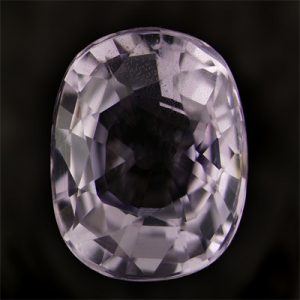Magnesiotaaffite-2N’2S
Taaffeite (pronounced TARF-ite) is one of the rarest gems. It was originally thought to be mauve colored Spinel but was found to be doubly refractive. This is impossible in the isometric crystal system of Spinel. Except for double refraction, Taaffeite has properties that are almost identical to Spinel such as hardness, density and index of refraction. Taaffeite reacts to most gemological tests like mauve colored Spinel, but can be distinguished from Spinel by its birefringence. It is found in shades of pink, mauve or grayish violet and colorless. The most notable occurance of Taaffeite is in the alluvial deposites in Sri Lanka. Taaffeite has also been found in Myanmar (Burma), Tanzania and Långban, Filipstad, Värmland, Sweden.
Taaffeite was originally named after Count Edward Charles Richard Taaffe (1898 – 1967), a Bohemian-Irish gemologist, who discovered the first specimen. It has recently been renamed Magnesiotaaffeite-2N’2S as a method of clarifying the complexity of the compositions of Taaffeite group minerals including Musgravite, Perhmanite and Taaffeite and the influences of the minerals Spinel and Nolanite on them. The Taaffeite group is redefined for minerals composed of Spinel and modified Nolanite modules. The modified Nolanite module has the composition BeTM4O8. If the Spinel module is dominated by the Spinel component, MgAl2O4, the prefix ‘magnesio’ is used. If the Spinel module is dominated by the Hercynite component, FeAl2O4, the prefix ‘ferro’ is used.
So, according to the new nomenclature accepted by the IMA (International Mineralogical Association), Taaffeite has become Magnesiotaaffeite-2N’2S, as it is composed of two modified Nolanite modules (2N) and two Spinel modules (2S). Correspondingly, Musgravite has become Magnesiotaaffeite-6N’3S and Perhmanite has become Ferrotaaffeite-6N’3S. Taaffeite is now an IMA approved name for the group of minerals containing Musgravite (Magnesiotaaffeite-6N’3S), Perhmanite (Ferrotaaffeite-6N’3S) and Taaffeite (Magnesiotaaffeite-2N’2S). The name Musgravite has been relegated to trade name status. However, I suspect that the names Taaffeite and Musgravite will continue to be used in the gem trade as the individual gem names.
| Chemical Formula: | Mg3Al8BeO16 |
| Magnesium Aluminum Beryllium Oxide | |
| Molecular Weight: | 553.77 gm |
| Composition: | Magnesium | 13.17 % | Mg | 21.83 % | MgO |
| Beryllium | 1.63 % | Be | 4.52 % | BeO | |
| Aluminum | 38.98 % | Al | 73.65 % | Al2O3 | |
| Oxygen | 46.23 % | O | |||
| 100.00 % | 100.00 % | = TOTAL OXIDE |
| Crystallography: | Hexagonal – Dihexagonal Pyramidal |
| Crystal Habit: | Crystals are hexagonal, pyramidal or flattened, to 2 cm, may be intergrown with Nigerite or Hogbomite; in fine-grained aggregates. Typically found as tumbled stones in gem gravels. |
| Twinning: | Possible on {0001} |
| Cleavage: | Fair on {001} |
| Fracture: | Irregular/Uneven, Conchoidal |
| Tenacity: | Brittle |
| Moh’s Hardness: | 8.0 – 8.5 |
| Density: | 3.605 – 3.613 (g/cm3) |
| Luminescence: | None |
| Radioactivity: | Not Radioactive |
| Color: | Mauve, Lilac, Pink, Violet Red, Red, Brown, deep to pale Grayish Purple, Blue, Greenish, pale Beige-Gray, may be nearly Colorless. |
| Transparency: | Transparent to Translucent |
| Luster: | Vitreous |
| Refractive Index: | 1.717 – 1.736 Uniaxial ( – ); may be anomalously Biaxial |
| Birefringence: | 0.0550 |
| Dispersion: | n/a |
| Pleochroism: | E= yellow rose; 0 = carmine red (for a deep red example) |


